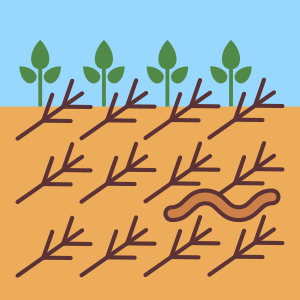Material required (for the manual method)
- Hand-held dirt ripper tool
- Hand hoe
- Hand jab planter or animal drawn direct planter (for seed planting) or planting stick (stick with sharpened point used to create holes to plant the seeds)
- Wheelbarrow to transport mulch
- Shallow weeder, zamwipe, hand push weeder (for superficial weeding)
- Slasher, machete, billhook (to remove weed, and cover crop for pre-planting operation)
Steps of Implementation
Besides the constant cropland cover, conservation agriculture is based on three pillars:
- Minimum soil disturbance (i.e., minimum or no tillage), just enough to allow the seed to get into the ground.
- Permanent organic soil cover (by using either previous crop residues or a cover crop specifically planted to cover the soil)
- Crop rotation, with varied sequences and associations, also including legumes.
No tillage or minimum tillage is the most common conservation agricultural practice for annual crops. This approach entails managing the land without disturbing the soil, or with the least disturbance. Digging and turning soil with machinery overexposes it to air, causing a rapid oxidation of the organic substance, which in turn compromises the soil structure. However, to facilitate water infiltration into the soil, more gentle practices such as soil ripping can be used.
Conservation agriculture also imposes to sow the new crop over previous crop residues, in order to keep a permanent soil coverage. Permanent groundcover is a widely used practice for perennial crops, thanks to which, the soil surface between rows of crops is covered and thus protected from erosion. For the cover it is possible to use either sown cover crops, spontaneous vegetation or inert crops, i.e. pruning residues or tree leaves (see also Mulching and techniques used in the Kitchen gardens). For a detailed step-by-step on how to adopt conservation agriculture, please click here.
This intervention contributes to:


Estimation of Socioeconomic factors of the intervention in Kenya, 2012
| Establishment costs |
Total cost, including labor, tools, seeds, fertilizer, and biocides: US $1.35/ha |
| Labor time |
5 person days/ha |
| Maintenance cost |
Weeding, harvesting, and reseeding: US $1.2/ha |
Source. If you want to know more about the benefits of conservation agriculture, watch this video.
India:
India has widely implemented conservation agriculture and other forms of sustainable agriculture in the past years. Successful results have been obtained especially when implementing rice-wheat systems, click here to find an example.
Brazil:
Conservation agriculture has been widely tested and practiced throughout Brazil. Click here to read about a successful case study in which conservation agriculture has been implemented for the cultivation of soybeans.
Switzerland:
After years of stressing the soil with big machinery and intense soil tillage, the no-tillage method is being tested as a sustainable solution to save soil quality and water while decreasing labor and other cost investments. Click here to read about a case study in Switzerland.
Other case studies:
If you want to know more about conservation agriculture worldwide and have an insight on the lessons learned, here is an interesting article.


